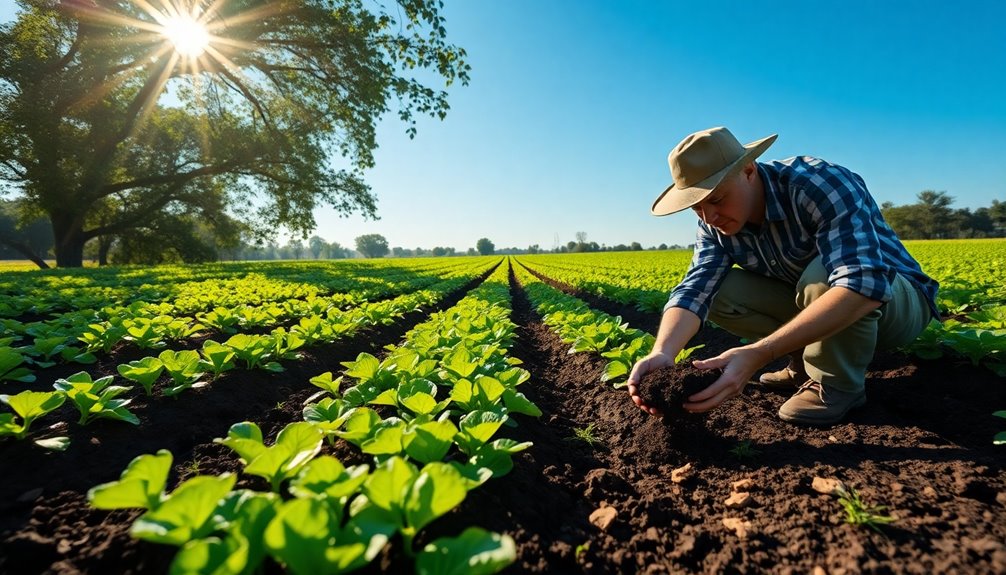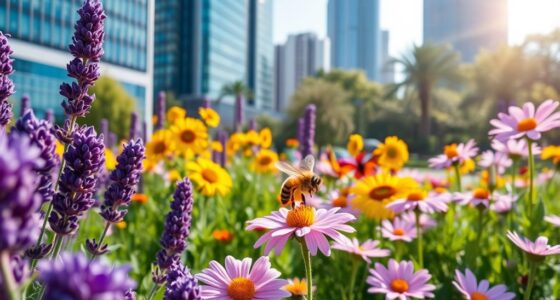You can leverage lignin's potential to enhance your farming practices sustainably. This abundant biopolymer improves soil structure, fertility, and reduces synthetic chemical use. By utilizing lignin-derived products like fertilizers and pesticides, you'll support healthier ecosystems while contributing to a circular economy. Although challenges like its complex structure exist, advancements in extraction and biotechnology can unlock more applications. Explore how optimizing lignin can further transform your agricultural methods for a greener approach to farming.
Key Takeaways
- Lignin enhances soil structure and fertility, promoting healthier crops and reducing the need for synthetic fertilizers.
- Its antimicrobial properties can protect plants, minimizing reliance on chemical pesticides in farming.
- Utilizing lignin contributes to a circular economy by repurposing agricultural waste and reducing landfill contributions.
- Advanced extraction methods and biotechnology optimize lignin use, facilitating cost-effective, high-value agricultural applications.
- Lignin valorization supports sustainable practices, lowering greenhouse gas emissions and fostering eco-friendly farming methods.

As you explore sustainable farming solutions, consider lignin valorization—a promising approach that transforms this abundant biopolymer into valuable agricultural products. Derived primarily from agricultural waste and the pulp and paper industries, lignin constitutes the second most abundant biopolymer in land-based biomass. Unfortunately, about 98% of the 100 million tons produced annually ends up as low-value fuel. By focusing on lignin valorization, you can tap into its potential to create fertilizers, pesticides, soil improvers, and plant growth regulators, which can significantly enhance agricultural practices.
Lignin's antimicrobial properties provide a compelling reason to incorporate it into your farming operations. By utilizing lignin-derived materials, you can improve soil structure and fertility while reducing reliance on synthetic chemicals. Ongoing research is dedicated to optimizing lignin's structure for agricultural applications, making it increasingly viable for diverse uses. However, challenges remain, particularly due to lignin's complex structure and variability, which complicate its full exploitation. Moreover, the structural variations in lignin hinder its complete utilization across different biomass feedstocks.
Incorporating lignin into farming enhances soil health and reduces chemical use, despite challenges in its complex structure.
The lack of standardized extraction and conversion technologies can hinder progress. Economic viability often hinges on efficient conversion processes and high-value applications. Since the pulp and paper industry serves as a primary source of lignin, the decreasing volume poses additional concerns.
Nevertheless, technological advancements are paving the way for novel extraction methods, such as steam-assisted and solvent-based fractionation. Exploring options like genetic engineering and microbial biotechnology could further enhance lignin's potential.
Moreover, the environmental benefits of lignin valorization are noteworthy. By reducing greenhouse gas emissions compared to fossil-based products, you contribute to a circular economy that utilizes biomass waste effectively. Implementing lignin in your agricultural practices helps minimize chemical pollution and supports healthier ecosystems.
As the market for lignin-based products grows, overcoming scalability and cost challenges will be essential. With continued research and technological advancements, lignin valorization can play a crucial role in cultivating greener, sustainable farming practices.
Frequently Asked Questions
What Is Lignin and Why Is It Important for Agriculture?
Lignin's a complex organic polymer found in plant cell walls, crucial for their structural integrity. It provides strength and rigidity, helping plants resist biotic and abiotic stresses.
In agriculture, lignin impacts microbial fermentation and nutrient cycling, affecting soil health and livestock digestibility. While it can pose challenges, understanding lignin's role allows you to explore innovative solutions for sustainable practices, ensuring healthier crops and improved agricultural efficiency.
How Can Lignin Be Extracted From Biomass?
When you think of lignin extraction, imagine a balancing act between efficiency and sustainability.
You can extract lignin using methods like mechanical pretreatment, where you reduce biomass size, or through alkaline extraction, which breaks down lignin at high temperatures.
Alternatively, consider the organosolv process, preserving lignin's structure.
Each method has its pros and cons, allowing you to choose an approach that aligns with your goals for biomass utilization and environmental impact.
Are There Any Health Risks Associated With Lignin Use in Farming?
Yes, there are some health risks associated with lignin use in farming.
While lignin itself isn't typically toxic to humans, improper handling or excessive exposure can pose risks.
You should also be aware that lignin's presence in wastewater from pulping can be harmful to aquatic life.
It's essential to consider these factors carefully, especially when integrating lignin into your farming practices, to ensure safety for both workers and the surrounding environment.
What Crops Benefit Most From Lignin-Based Fertilizers?
You'll find that various crops benefit significantly from lignin-based fertilizers.
For instance, Choy Sum shows improved yields, while common beans experience increased biomass. Maize thrives with enhanced root growth.
In general, crops see better height, stem diameter, and overall dry weight due to the sustained nutrient release from these fertilizers.
How Does Lignin Valorization Impact Soil Health Long-Term?
Imagine your garden thriving like a well-tended library, each plant a book filled with life.
Lignin valorization enriches soil health over time, acting like a well-organized shelf, ensuring nutrients are readily available. It enhances structure, boosts microbial activity, and improves water retention, creating a vibrant ecosystem.
Conclusion
Incorporating lignin valorization into your farming practices isn't just a clever idea — it's your ticket to a greener future. By transforming this abundant yet often overlooked resource, you're not just boosting soil health; you're also nurturing the planet. Embracing these innovative approaches allows you to cultivate not just crops, but a legacy of sustainability. So, why not turn this hidden gem into your farming silver lining? It's time to sow the seeds of change for a brighter tomorrow.








